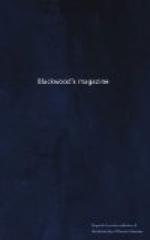steeds were all of that generous breed which the
rich plains of Thessaly alone produce, and pawed
the ground as if impatient of the bit by which
their ardour was restrained by their riders; and
the silver and gold which glittered on their frontlets
and caparisons, showed the rivalry prevailing
among these cavaliers in the splendour of the
equipments, rather of their coursers than themselves.
But it was on him who rode in the midst of this
gallant party, eclipsing all his comrades as the glare
of lightning seems to obscure all lesser luminaries,
that the eyes of the gazing crowd were now fixed.
He was completely armed at all points, except
his head, and grasped in his hand an ashen lance;
while a scarlet cloak, on which was depicted, in figures
of gold tissue, the battle of the Centaurs with
the Lapithae, flowed loose over his panoply,
and was fastened in front with a clasp, representing
Pallas sculptured in amber, and holding before
her the Gorgon’s head on her shield. The
breeze, which blew back his locks from his forehead,
gave his features more fully to view; and even
the horse which bore him seemed to move with
a statelier gait, arching his neck and proudly caracoling,
as if conscious of the noble presence of his master;
while the admiration of the surrounding multitude
burst out into a spontaneous shout of applause,
and some of the women of the lower class even
threw fruit and flowers towards him, in the hope,
I suppose, of drawing on themselves a glance of acknowledgement
from his eye.”
[Footnote 58: The incidents of the birth of Chariclea
have been copied by Tasso in the story of Clorinda,
as related to her by Arsete, in the 12th canto of
“Gierusalemme Liberata.” In the “Shah-Nameh,”
also, Zal, the father of the Persian hero Rustan,
being born with white hair, is exposed by his
father Sam on the mountain of Elborz, where he is
preserved and brought up by the giant-bird Simorgh.]
[Footnote 59: “In the royal character”—“[Greek:
grammasin Aithiopikois oy demotikois, alla basilikois].”
This distinction between the royal and popular system
of hieroglyphics, as well as the etiquette, before
mentioned, of inscribing the title of the king within
a circle or oval, is borrowed, as need hardly be mentioned,
from the monuments of Egypt.]
The cavalier thus eulogized by Calasiris is of course
Theagenes, who, after thrice encompassing in due form
the tomb of Neoptolemus, at length reaches the Temple
of Apollo; but, during the performance of the ceremonial,
it falls to his lot to receive the torch with which
the altar is to be kindled from the hand of Chariclea,
and love at first sight, mutual and instantaneous,
is the result. The aid of Calasiris is again
invoked by both the lovers; and the good old gentleman,
whose knowledge of the Ethiopian hieroglyphics, by
enabling him to decipher the mysterious inscription
on the fillet, has put him in possession of the true
parentage of Chariclea, (which he does not, however,




